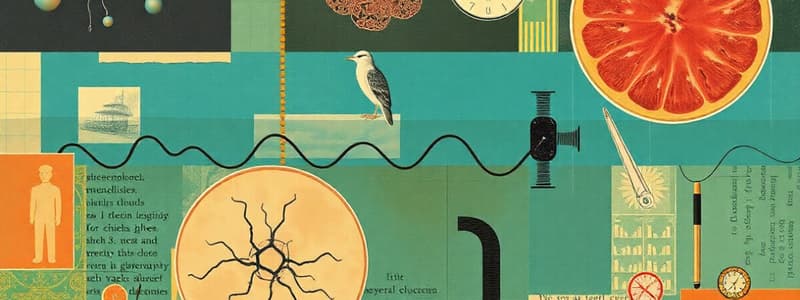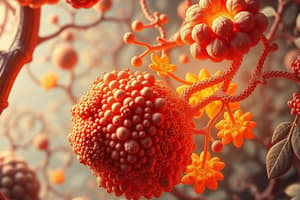Podcast
Questions and Answers
Which metabolic process occurs in the endoplasmic reticulum during gluconeogenesis?
Which metabolic process occurs in the endoplasmic reticulum during gluconeogenesis?
- Conversion of pyruvate to phosphoenolpyruvate
- Carboxylation of pyruvate to oxaloacetate
- Hydrolysis of glucose-6-phosphate to glucose (correct)
- Hydrolysis of fructose-1,6-bisphosphate to fructose-6-phosphate
In gluconeogenesis, which enzyme is responsible for bypassing the irreversible step catalyzed by phosphofructokinase in glycolysis?
In gluconeogenesis, which enzyme is responsible for bypassing the irreversible step catalyzed by phosphofructokinase in glycolysis?
- Pyruvate carboxylase
- Glucose-6-phosphatase
- Fructose-1,6-bisphosphatase (correct)
- Phosphoenolpyruvate carboxykinase
Why is the conversion of oxaloacetate to aspartate or malate significant in gluconeogenesis?
Why is the conversion of oxaloacetate to aspartate or malate significant in gluconeogenesis?
- To replenish the supply of biotin in the mitochondrial matrix
- To inhibit the activity of pyruvate carboxylase
- To facilitate the transport of oxaloacetate equivalents from the mitochondria to the cytosol (correct)
- To directly produce phosphoenolpyruvate in the cytosol
Which of the following is an accurate description of the regulation of gluconeogenesis and glycolysis?
Which of the following is an accurate description of the regulation of gluconeogenesis and glycolysis?
How does biotin participate in the pyruvate carboxylase reaction during gluconeogenesis?
How does biotin participate in the pyruvate carboxylase reaction during gluconeogenesis?
What is the metabolic consequence of gluconeogenesis enzymes being present in the cytosol, with the exception of glucose-6-phosphatase in the ER and pyruvate carboxylase in the mitochondria?
What is the metabolic consequence of gluconeogenesis enzymes being present in the cytosol, with the exception of glucose-6-phosphatase in the ER and pyruvate carboxylase in the mitochondria?
Which of the following describes the significance of gluconeogenesis enzymes being tightly regulated?
Which of the following describes the significance of gluconeogenesis enzymes being tightly regulated?
Considering the Cori cycle, what is the primary metabolic role of lactate produced in muscle cells during intense exercise?
Considering the Cori cycle, what is the primary metabolic role of lactate produced in muscle cells during intense exercise?
How does the glyoxylate cycle in plants contribute to gluconeogenesis?
How does the glyoxylate cycle in plants contribute to gluconeogenesis?
Why is gluconeogenesis essential for brain and red blood cell function?
Why is gluconeogenesis essential for brain and red blood cell function?
How does the average chain length of the branches affect glycogen structure and function?
How does the average chain length of the branches affect glycogen structure and function?
What is the primary function of α-amylase in glycogen breakdown?
What is the primary function of α-amylase in glycogen breakdown?
Why is phosphorolysis, rather than hydrolysis, used by glycogen phosphorylase to cleave glucose from glycogen?
Why is phosphorolysis, rather than hydrolysis, used by glycogen phosphorylase to cleave glucose from glycogen?
Glycogen phosphorylase is regulated through both allosteric control and covalent modification. How do these regulatory mechanisms interact in a 'fight or flight' situation?
Glycogen phosphorylase is regulated through both allosteric control and covalent modification. How do these regulatory mechanisms interact in a 'fight or flight' situation?
How does pyridoxal phosphate (PLP) participate in glycogen phosphorylase activity?
How does pyridoxal phosphate (PLP) participate in glycogen phosphorylase activity?
During glycogen synthesis, what is the role of UDP-glucose pyrophosphorylase?
During glycogen synthesis, what is the role of UDP-glucose pyrophosphorylase?
What is the specific role of glycogenin in glycogen synthesis?
What is the specific role of glycogenin in glycogen synthesis?
In the context of glycogen metabolism, how do insulin and glucagon affect blood glucose levels?
In the context of glycogen metabolism, how do insulin and glucagon affect blood glucose levels?
Which statement accurately describes the impact of cortisol and glucocorticoids on glycogen and glucose metabolism?
Which statement accurately describes the impact of cortisol and glucocorticoids on glycogen and glucose metabolism?
What is the role of the pentose phosphate pathway in biosynthesis?
What is the role of the pentose phosphate pathway in biosynthesis?
What is the metabolic consequence of the irreversible first step of the pentose phosphate pathway being highly regulated by NADPH?
What is the metabolic consequence of the irreversible first step of the pentose phosphate pathway being highly regulated by NADPH?
In the non-oxidative phase of the pentose phosphate pathway, how are the C5 sugars ribose-5-phosphate and xylulose-5-phosphate interconverted to produce glyceraldehyde-3-phosphate and fructose-6-phosphate?
In the non-oxidative phase of the pentose phosphate pathway, how are the C5 sugars ribose-5-phosphate and xylulose-5-phosphate interconverted to produce glyceraldehyde-3-phosphate and fructose-6-phosphate?
How is the partitioning of glucose-6-phosphate between glycolysis and the pentose phosphate pathway regulated to meet cellular needs?
How is the partitioning of glucose-6-phosphate between glycolysis and the pentose phosphate pathway regulated to meet cellular needs?
What is the significance of tissues like the liver and adipose tissue being the primary sites for the pentose phosphate pathway?
What is the significance of tissues like the liver and adipose tissue being the primary sites for the pentose phosphate pathway?
Which of the following is the consequence of unregulated digestive breakdown of starch?
Which of the following is the consequence of unregulated digestive breakdown of starch?
What distinguishes the function of tissue glycogen from digested starch?
What distinguishes the function of tissue glycogen from digested starch?
In the context of glycogen breakdown, what would be the outcome if glycogen phosphorylase used hydrolysis instead of phosphorolysis?
In the context of glycogen breakdown, what would be the outcome if glycogen phosphorylase used hydrolysis instead of phosphorolysis?
How does hormone-activated signaling influence covalent modification in glycogen phosphorylase regulation?
How does hormone-activated signaling influence covalent modification in glycogen phosphorylase regulation?
Glycogen synthase catalyzes the addition of UDP-glucose during glycogenesis. How does this enzyme encourage this?
Glycogen synthase catalyzes the addition of UDP-glucose during glycogenesis. How does this enzyme encourage this?
The pentose phosphate pathway may be regulated by several factors. If a cell is trying to create nucleic acids, but create as little NADPH as possible, how would it adjust the pentose phosphate pathway?
The pentose phosphate pathway may be regulated by several factors. If a cell is trying to create nucleic acids, but create as little NADPH as possible, how would it adjust the pentose phosphate pathway?
Flashcards
What is Gluconeogenesis?
What is Gluconeogenesis?
The synthesis of glucose from non-carbohydrate precursors.
Which cells depend greatly on glucose for energy?
Which cells depend greatly on glucose for energy?
Brain and red blood cells.
Where does gluconeogenesis mainly occur?
Where does gluconeogenesis mainly occur?
Liver (90%) and Kidney (10%).
What are precursors for gluconeogenesis?
What are precursors for gluconeogenesis?
Signup and view all the flashcards
What bypasses Pyruvate Kinase?
What bypasses Pyruvate Kinase?
Signup and view all the flashcards
What bypasses Phosphofructokinase?
What bypasses Phosphofructokinase?
Signup and view all the flashcards
What bypasses Hexokinase?
What bypasses Hexokinase?
Signup and view all the flashcards
What is Gluconeogenesis & Glycolysis together?
What is Gluconeogenesis & Glycolysis together?
Signup and view all the flashcards
Where are gluconeogenesis enzymes located?
Where are gluconeogenesis enzymes located?
Signup and view all the flashcards
What does Pyruvate Carboxylase do?
What does Pyruvate Carboxylase do?
Signup and view all the flashcards
What does Acetyl CoA do in gluconeogenesis?
What does Acetyl CoA do in gluconeogenesis?
Signup and view all the flashcards
What cofactor does Pyruvate Carboxylase require?
What cofactor does Pyruvate Carboxylase require?
Signup and view all the flashcards
What does PEP carboxykinase do?
What does PEP carboxykinase do?
Signup and view all the flashcards
What does Fructose 1,6 Bisphosphatase do?
What does Fructose 1,6 Bisphosphatase do?
Signup and view all the flashcards
Where does Fructose 1,6 Bisphosphatase happen?
Where does Fructose 1,6 Bisphosphatase happen?
Signup and view all the flashcards
What does Glucose 6-Phosphatase do?
What does Glucose 6-Phosphatase do?
Signup and view all the flashcards
Where does Glucose 6-Phosphatase happen?
Where does Glucose 6-Phosphatase happen?
Signup and view all the flashcards
Where does gluconeogensis not occur?
Where does gluconeogensis not occur?
Signup and view all the flashcards
What happens when cell doesn't need ATP & NADH?
What happens when cell doesn't need ATP & NADH?
Signup and view all the flashcards
What happens when cell needs ATP and NADH?
What happens when cell needs ATP and NADH?
Signup and view all the flashcards
How is gluconeogenesis regulated?
How is gluconeogenesis regulated?
Signup and view all the flashcards
What is PEP carboxykinase?
What is PEP carboxykinase?
Signup and view all the flashcards
What affects phosphorylation?
What affects phosphorylation?
Signup and view all the flashcards
What is a-Amylase?
What is a-Amylase?
Signup and view all the flashcards
What does Debranching Enzyme do?
What does Debranching Enzyme do?
Signup and view all the flashcards
How is digestive breakdown of starch?
How is digestive breakdown of starch?
Signup and view all the flashcards
What does Glycogen Phosphorylase do?
What does Glycogen Phosphorylase do?
Signup and view all the flashcards
How is Glycogen Phosphorylase tightly regulated?
How is Glycogen Phosphorylase tightly regulated?
Signup and view all the flashcards
What situations activate Glycogen Phosphorylase?
What situations activate Glycogen Phosphorylase?
Signup and view all the flashcards
What does Insulin do?
What does Insulin do?
Signup and view all the flashcards
What else does Cortisol & Glucocorticoid do?
What else does Cortisol & Glucocorticoid do?
Signup and view all the flashcards
What does Pentose Phosphate Pathway do?
What does Pentose Phosphate Pathway do?
Signup and view all the flashcards
Where does Pentose Phosphate Pathway operate?
Where does Pentose Phosphate Pathway operate?
Signup and view all the flashcards
The flux through pentose phosphate pathway & rate of ____ controlled at 1st step.
The flux through pentose phosphate pathway & rate of ____ controlled at 1st step.
Signup and view all the flashcards
What is notable about Glucose-6-phosphate dehydrogenase?
What is notable about Glucose-6-phosphate dehydrogenase?
Signup and view all the flashcards
Study Notes
- Gluconeogenesis means "making new glucose"
What is Gluconeogenesis?
- Cells depend on glucose for energy
- The brain and red blood cells depend almost entirely on glucose
- Liver-stored glycogen provides enough glucose to supply the brain for 1½ days during fasting
- If glucose isn't from diet, the body will produce glucose from non-carbohydrate precursors
- Gluconeogenesis is how new sugar is generated
Gluconeogenesis Substrates
- Lactate and pyruvate are converted into new glucose
- Most amino acids from protein hydrolysis become glucose
- Glycerol (TAG hydrolysis) forms glucose, but not fatty acids
- Animals cannot use acetyl CoA to synthesize glucose
- Plants use acetyl CoA as a substrate to make glucose via the glyoxalate cycle
- This process occurs primarily in the liver (90%) and kidneys (10%)
- Microorganisms use acetate & propionate as gluconeogenesis substrates
Gluconeogenesis and Glycolysis
- Gluconeogenesis and glycolysis are opposing metabolic pathways
- They differ in three ways, because the strongly exergonic reactions of glycolysis are bypassed:
- Pyruvate kinase is bypassed by pyruvate carboxylase & PEP carboxykinase
- Phosphofructokinase is bypassed by fructose-1,6-bisphosphatase
- Hexokinase is bypassed by glucose-6-phosphatase
Glycolysis Net Reaction
- Glucose + 2 NAD+ + 2 ADP + 2 Pi yields 2 Pyruvate + 2 NADH + 2 H+ + 2 ATP + 2 H2O
Gluconeogenesis Net Reaction
- 2 Pyruvate + 2 NADH + 2 H+ + 4 ATP + 2 GTP + 6 H2O yields Glucose + 2 NAD+ + 4 ADP + 2 GDP + 6 Pi
- 2 ATP + 2 GTP + 4 H2O yields 2 ADP + 2 GDP + 4 Pi
- This is a wasteful futile cycle, so it is tightly regulated
Gluconeogenesis Enzymes
- Gluconeogenesis enzymes are in the cytosol, except:
- Glucose-6-phosphatase in the ER
- Pyruvate carboxylase in the mitochondria
Unique Reactions of Gluconeogenesis: Bypass I
- Pyruvate becomes oxaloacetate, which becomes phosphoenolpyruvate
- This bypasses Pyruvate kinase
Pyruvate Carboxylase
- Pyruvate carboxylase is used for carboxylation in the mitochondrial matrix
- Acetyl CoA activates this
- Bicarbonate is needed
- Biotin is a cofactor
- Oxaloacetate is too polar to pass through mitochondrial membranes, so it converts to aspartate or malate for transport
Phosphoenolpyruvate Carboxykinase
- Phosphoenolpyruvate carboxykinase facilitates decarboxylation
- It occurs in the cytosol
- Oxaloacetate is a high-energy intermediate
- Its exergonic decarboxylation provides the free energy to form PEP
- Beta-ketoacids are 'high energy' intermediates
- Loss of CO2 generates a strong enolate
Pyruvate Carboxylase details
- It is a Biotin-Dependent Enzyme
- The enzyme covalently links biotin to an active-site lysine
- The nitrogen at the bottom of the structure transfers the one-carbon unit to pyruvate
- Bicarbonate must be activated for attack by the pyruvate carbanion, which is driven by ATP
Unique Reactions of Gluconeogenesis: Bypass II
- Fructose 1,6-Bisphosphate becomes Fructose 6-Phosphate
- Phosphofructokinase is replaced
Fructose 1,6-Bisphosphatase
- It is used for Phosphoester hydrolysis
- It occurs in the cytosol
Unique Reactions of Gluconeogenesis: Bypass III
- Glucose 6-Phosphate becomes Glucose
- Hexokinase is replaced
Glucose 6-Phosphatase
- It is used for Phosphoester hydrolysis
- It occurs in the ER
Location Specificity
- Glucose 6-phosphatase is not present in the muscle or brain
- Gluconeogenesis cannot occur in these organs because of this
- Glucose is exported from the ER into the blood stream
- It goes to the brain and carries out glycolysis there
Glycogen Storage
- Higher animals store excess glucose as glycogen
- Glycogen phosphorylase facilitates Glycogen breakdown into Glucose
- Glycogen synthase facilitates the synthesis of Glu into Glycogen
Glucose Activation
- Glucose is activated by the formation of nucleotide sugars
- Sugar Nucleotides are activated sugar units
- UDP-glucose is a donor for glycogen biosynthesis in animals
- Nucleotide labels mark sugar for biosynthesis
- ADP-glucose is a donor for starch biosynthesis in plants
- UDP-glucose Pyrophosphorylase is used
Gluconeogenesis Regulation
- Glycolysis is ON when the cell needs ATP & NADH
- Gluconeogenesis is ON when the cell doesn’t need ATP & NADH and has excess lactate/pyruvate and the cell wants to store glucose as glycogen
Regulation Mechanisms
- Substrate-level control of Gluocose-6-phosphatase
- Allosteric regulation via Fructose-2,6,-Bisphosphate & Acetyl CoA
- Covalent modification (Phosphorylation/Dephosphorylation via cAMP) allows for hormonal control
- Transcriptional control of gene encoding PEP carboxykinase
Regulating Cellular processes
- Glycogen metabolism and blood glucose levels are hormonally regulated
- Insulin lowers blood glucose
- Glucagon raises blood glucose
- The body maintains blood glucose levels at approximately 4.5 mM
Insulin
- Insulin increases glucose permeability in muscle and adipose tissue, triggering glycolysis, glycogen synthesis, and triacylglycerol synthesis
Glucagon
- Glucagon increases cyclic AMP in the liver and adipose tissue, leading to glycogen breakdown and high blood glucose levels
Epinephrine
- Epinephrine increases cyclic AMP levels in skeletal muscle, leading to triacylglycerol hydrolysis, glycogen breakdown, and increased blood glucose levels
Cortisol and Glucocorticoid
- Cortisol and Glucocorticoid are hormones used for long-term stress
- Glucocorticoid affects the liver, skeletal muscle, and adipose tissue
- It promotes protein breakdown and decreases protein synthesis
- It stimulates gluconeogenesis and glycogen synthesis (transcriptional control)
Glucose Metabolism Reactions
- The pentose phosphate pathway operates in the liver & adipose tissue & generates NADPH (reducing power) & ribose-5-phosphate
- ATP is the cell's "energy" currency
- NADPH drives endergonic reductive biosynthesis
- The pentose phosphate pathway is an alternative pathway to glycolysis
Glucose Metabolism Overall Net Reaction
- 3 Glucose-6-P + 6 NADP+ + 3 H2O yields 6 NADPH + 6 H+ + 3 CO2 + 2 Fructose-6-P + Glyceraldehyde-3-P
Glucose Metabolism Three Stages of Pentose Phosphate Pathway
-
- Oxidative Reactions
-
- Isomerization & Epimerization Reactions
-
- C–C Bond Cleavage & Formation Reactions
Glucose-6-Phosphate
- Glucose-6-Phosphate is a crucial branch point in glycolysis & the pentose phosphate pathway
NADPH
- Flux through the pentose phosphate pathway and the rate of NADPH production are controlled at the 1st step (glucose-6-phosphate dehydrogenase)
- ATP is made by having glucose-6-P enter glycolysis
- NADPH or Ribose-5-P are made by having glucose-6-P enter the pentose phosphate pathway
Possibilities for Pentose Phosphate Pathway
- (1) Both ribose-5-phosphate & NADPH are needed
- (2) More ribose-5-phosphate than NADPH is needed
- (3) More NADPH than ribose-5-phosphate is needed
- (4) Both NADPH & ATP are needed, but ribose-5-phosphate is not
Studying That Suits You
Use AI to generate personalized quizzes and flashcards to suit your learning preferences.




